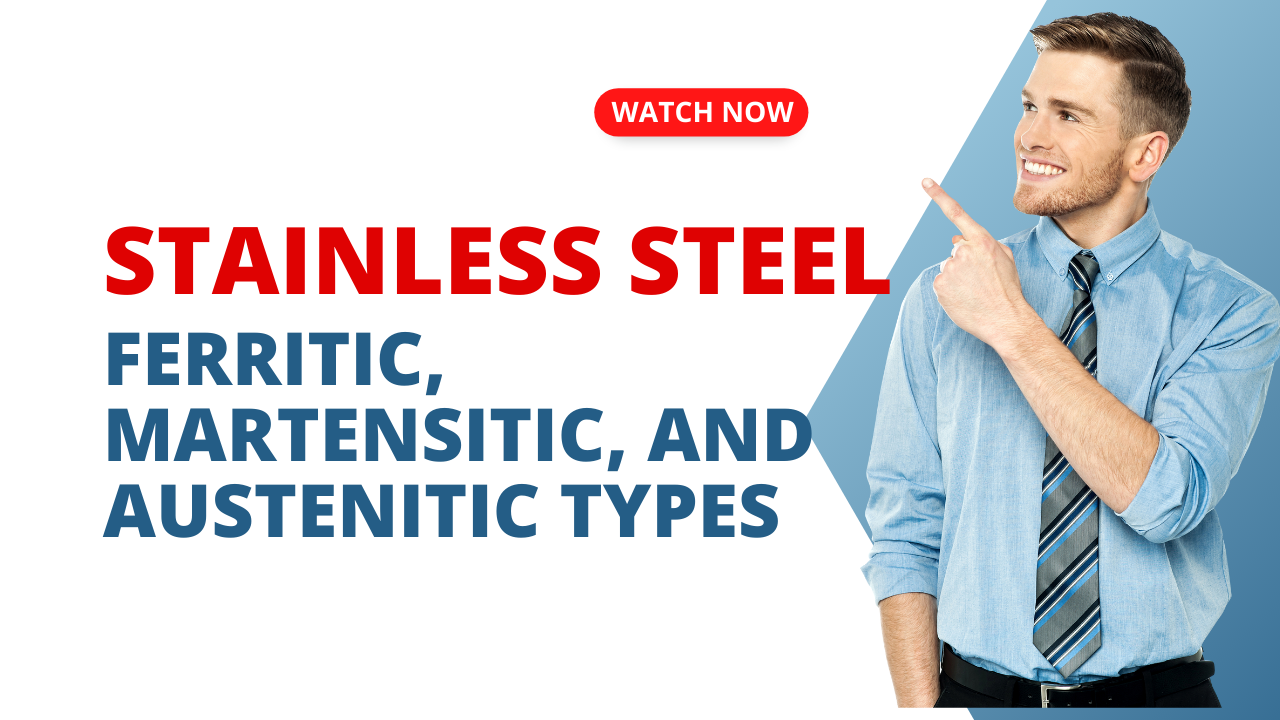Introduction
Stainless steel is an essential material in modern industries, known for its durability, corrosion resistance, and aesthetic appeal. Among its diverse types, Ferritic, Martensitic, and Austenitic stainless steel stand out. In this comprehensive guide, we’ll dive into the intricate details of these three types, uncovering their distinct features, applications, and advantages. Check out the hydrogen embrittlement details here.
Table of Contents
The Versatility of Stainless Steel: Ferritic, Martensitic, and Austenitic Types
Stainless steel, a remarkable alloy of iron, chromium, and other elements, owes its remarkable properties to the specific combination of these components. Within the vast world of stainless steel, three major types capture our attention: Ferritic, Martensitic, and Austenitic. Each type possesses unique attributes that make them invaluable in various applications.
Don’t miss the Complete Course on Piping Engineering: Check Now
By EPCLand.com
Ferritic Stainless Steel: Strength in Resistance
Ferritic stainless steel, characterized by its high chromium content and low carbon content, boasts exceptional corrosion resistance. It’s known for its magnetic properties, making it ideal for applications where magnetism is required. LSI Keywords: corrosion resistance, magnetic properties, high chromium content.
Martensitic Stainless Steel: Toughness and Hardenability
Martensitic stainless steel is celebrated for its impressive strength and hardness. It can be heat-treated to achieve even greater toughness, making it a popular choice in cutlery, medical instruments, and aerospace components. LSI Keywords: heat-treated, toughness, hardness.
Austenitic Stainless Steel: The Non-Magnetic Workhorse
Austenitic stainless steel, comprising significant amounts of nickel and chromium, excels in both corrosion resistance and formability. It’s non-magnetic and exhibits exceptional toughness, finding applications in everything from kitchen appliances to architectural structures. LSI Keywords: formability, non-magnetic, corrosion resistance.
Comparing the Three Types
When it comes to comparing Ferritic, Martensitic, and Austenitic stainless steel, several factors come into play. Each type has its own strengths and limitations, making them suitable for specific scenarios. Understanding these differences is crucial for selecting the right type for a given application.
Applications of Stainless Steel: Ferritic, Martensitic, and Austenitic Types
The versatility of stainless steel extends to its applications across various industries. Let’s explore how each type finds its place in the world of engineering, construction, and everyday products.
Ferritic Stainless Steel Applications
- Automotive exhaust systems: Ferritic stainless steel’s resistance to high-temperature corrosion makes it a prime choice for exhaust components.
- Cooking equipment: Its magnetic properties and corrosion resistance make it perfect for cookware.
- Decorative architecture: Ferritic stainless steel’s aesthetic appeal lends itself well to architectural accents.
Martensitic Stainless Steel Applications
- Cutlery and knives: The hardness and toughness of Martensitic stainless steel ensure sharpness and durability.
- Surgical instruments: Its resistance to corrosion and sterilization processes make it ideal for medical tools.
- Aerospace components: Martensitic stainless steel’s strength-to-weight ratio is invaluable in aviation.
Austenitic Stainless Steel Applications
- Food processing equipment: Its corrosion resistance and hygienic properties make it a staple in the food industry.
- Chemical and pharmaceutical tanks: Austenitic stainless steel withstands corrosive chemicals and maintains purity.
- Residential and commercial architecture: Its formability and longevity make it a popular choice for various structures.
Stainless Steel: Ferritic, Martensitic, and Austenitic Types – FAQ’s
What makes Austenitic stainless steel non-magnetic?
Austenitic stainless steel’s non-magnetic property is due to its crystal structure, specifically the FCC (face-centered cubic) arrangement of atoms, which doesn’t exhibit magnetic behavior.
Can Ferritic stainless steel be hardened through heat treatment?
Ferritic stainless steel is not typically heat-treated for hardening, as it is more focused on corrosion resistance and formability rather than achieving high strength.
How does Martensitic stainless steel achieve its hardness?
Martensitic stainless steel achieves its hardness through a process called martensitic transformation, which occurs when the alloy is rapidly cooled from a high temperature.
Are there any limitations to using Austenitic stainless steel?
Despite its many benefits, Austenitic stainless steel can be more expensive than other types and might not offer the same strength as Martensitic or Ferritic stainless steel in certain applications.
Can these stainless steel types be recycled?
Yes, all three types of stainless steel—Ferritic, Martensitic, and Austenitic—are fully recyclable, contributing to their sustainability and eco-friendliness.
What industries benefit most from Martensitic stainless steel?
Martensitic stainless steel finds significant use in industries requiring high-strength materials, such as aerospace, automotive, and cutlery manufacturing.
Conclusion
In the realm of stainless steel, the Ferritic, Martensitic, and Austenitic types stand as shining examples of ingenuity and innovation. Their unique characteristics and diverse applications underscore the incredible versatility of stainless steel. Whether it’s the corrosion resistance of Ferritic, the toughness of Martensitic, or the formability of Austenitic, each type has carved its niche in our modern world, contributing to the progress of various industries. As we continue to harness the potential of stainless steel, we’re reminded of the extraordinary journey that brings science, engineering, and practicality together in perfect harmony.
Recommended courses (Published on EPCLand):
- Basics of Piping Engineering
- Piping Layout Engineering
- Piping Material Engineering
- Piping Stress Analysis
- Complete Course on Piping Engineering
- Material Requisitions
- Piping Material Specifications
- Valve Material Specifications
Related Video
Attempt Quiz
Question 1:
Which type of stainless steel is magnetic and known for its corrosion resistance?
Explanation: Ferritic stainless steel is magnetic and known for its corrosion resistance, making it suitable for various applications, including automotive exhaust systems.
Question 2:
Which type of stainless steel is commonly used for cutlery and surgical instruments?
Explanation: Martensitic stainless steel is known for its high hardness and is commonly used for cutlery, surgical instruments, and other applications requiring sharp edges.
Question 3:
Which type of stainless steel is non-magnetic and has excellent corrosion resistance?
Explanation: Austenitic stainless steel is non-magnetic and known for its excellent corrosion resistance, making it suitable for a wide range of applications, including kitchen appliances and chemical processing.
Question 4:
Which type of stainless steel can be hardened by heat treatment and is used in applications requiring high strength?
Explanation: Martensitic stainless steel can be hardened by heat treatment and is used in applications requiring high strength and wear resistance, such as turbine blades and firearms.
Question 5:
Which type of stainless steel is commonly used in automotive exhaust systems due to its heat resistance?
Explanation: Ferritic stainless steel is commonly used in automotive exhaust systems due to its heat resistance and corrosion resistance at elevated temperatures.



